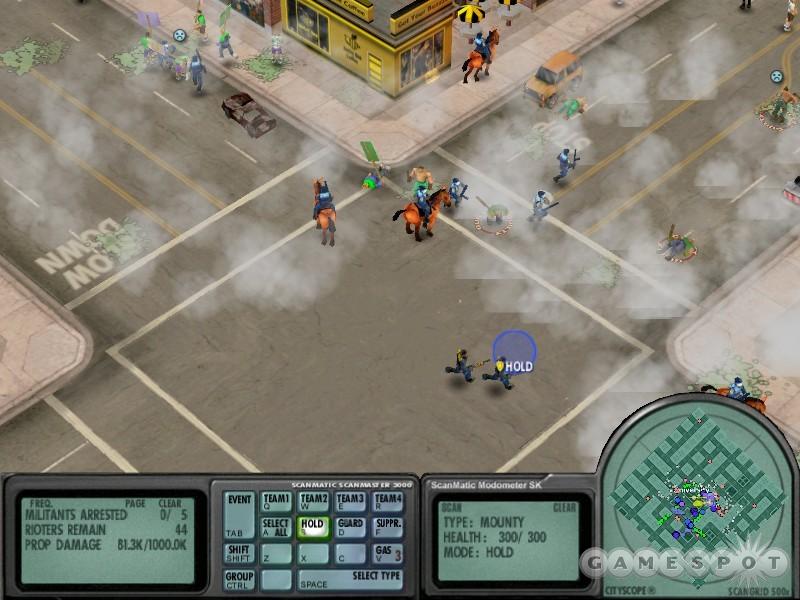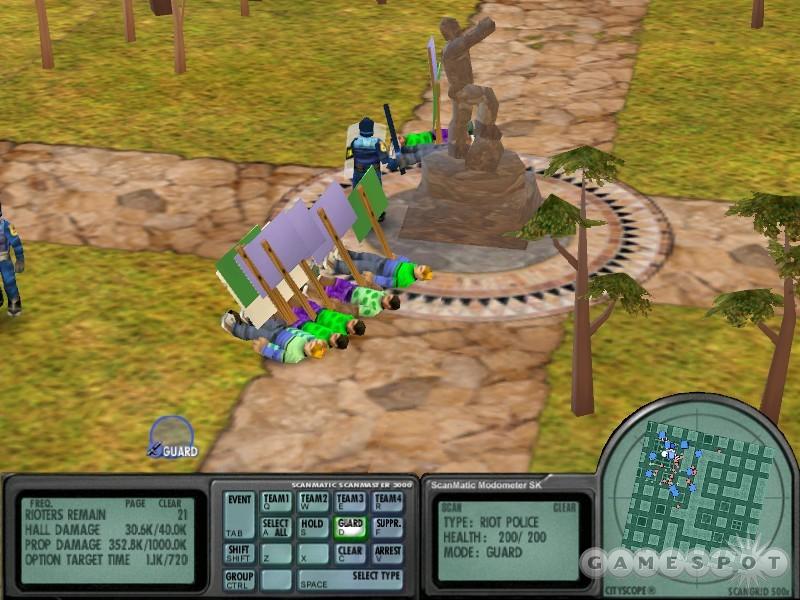Riot Police is one of those games that are usually more fun in theory than in practice. This real-time strategy game requires you to use different police units to quell angry mobs. Using nonlethal weapons, you engage in running battles with incensed union activists, enraged student protesters, wild football fans who rampage after a game, and more. You'll have to take crowd psychology into account or you'll do more harm than good if you use the wrong tactics and whip outraged bystanders into a frenzy. On paper, this game features some neat ideas, but control problems, micromanagement, and other flaws often make Riot Police a lot less fun than it could have been.
In Riot Police, you work through a linear series of 16 missions and a bonus mission. Superficially, at least, the missions are varied enough to make the game moderately interesting the first time through. They gradually introduce different units and feature varied goals, like keeping damage under a certain dollar amount or arresting a particular troublemaker among a crowd of vicious thugs. Unfortunately, there's only one game mode and no multiplayer options. There are no difficulty levels, which is a problem since some missions are very poorly balanced. On top of that, scripted events seem to play out the same way every time. All told, there's not a whole lot of depth, variety, or replay value in the long run.
You get six unit types with different strengths and weaknesses. Heavy riot police, for example, can set up cordons with their shields to knock onrushing hooligans backward. They're most effective en masse, and they run slowly, so you'll need to anticipate trouble spots early if you want to get them there in time. Standard riot police are a lot faster and can arrest people instead of just knocking them to the ground, but they can't endure much punishment. Other units can fire rubber bullets, tear gas, or other painful but nonlethal weapons.
Facing off against the boys in blue, protest leaders stay above the law while egging fellow demonstrators on, hooligans set out to destroy shops and vandalize cars just for kicks, and everyday citizens look on at your actions with satisfaction or join the lawbreakers if they get too agitated by the violence or think you've crossed the line. In fact, crowd control in the broadest sense is part of what makes this pretty simplistic and repetitive game more interesting than it would otherwise be. For example, indiscriminately firing tear gas into crowds or beating up everyone in sight can cause law-abiding passersby to join in the violence. Suddenly, you'll find your men grossly outnumbered and taking a beating. Colorful icons help you track these mood shifts among the populace.
Trying to coordinate your units is one of the best and worst things about Riot Police. On the one hand, it can be fun to try different tactics to ensure that your men work together to the best advantage. It's satisfying to send all the troublemakers packing and save the city from devastation. On the other hand, control and micromanagement problems often sap fun out of the game quicker than a rioter can hurl a brick. The controls feel clunky, often requiring multiple presses of the same button for it to register. You can zoom the camera in and out with the mouse, but you have to reach for the keyboard to swivel it. The minimap doesn't adequately display certain vital locales you'll need to protect. You can only hotkey four groups of men, which is often wholly inadequate for the large tasks at hand. Couple all that with pathfinding problems, weak artificial intelligence, and very limited line of sight, and it means you'll be doing lots and lots of babysitting if you want your cops to have a chance. Without your direct intervention all the time, they'll often stand by and do nothing as people burn down a store across the street or smash a nearby car. Needless to say, this can get very frustrating in a hurry.
On top of all that, you can't pause or save a game in progress. The lack of saves, in particular, is a real problem since hooligans can keep coming out of the woodwork on some missions until you somehow manage to arrest or drive them all off at once. Missions can drag on interminably.

At least there are plenty of neat things to see. The game wisely adopts a bright, cartoony style instead of trying to treat protests and police conduct seriously--those cans of worms don't really need to be opened in a basic action strategy game like this. The graphics sure don't push any technological limits, but they're nicely detailed and memorable. Animated signs flash or rotate above businesses, riot vehicles' water cannons send protesters tumbling across the street, charred cars remain in the wake of looters, and activists bend over and puke comically big green puddles onto the pavement after a tear gas grenade explodes nearby. The audio works nicely, too. The music is totally forgettable, but the voice-overs lend character to the game. For instance, when you clear an area of rioters, you might hear one dejectedly mumble, "Hey, let's go back to the dorm," as he skulks away.
Nevertheless, Riot Police is unlikely to hold your interest for very long, despite its unusual premise, a few good units, some interesting tactical possibilities, and nice little graphical and audio touches. Ultimately, it's a one-trick pony, and it just doesn't perform that trick particularly well.
